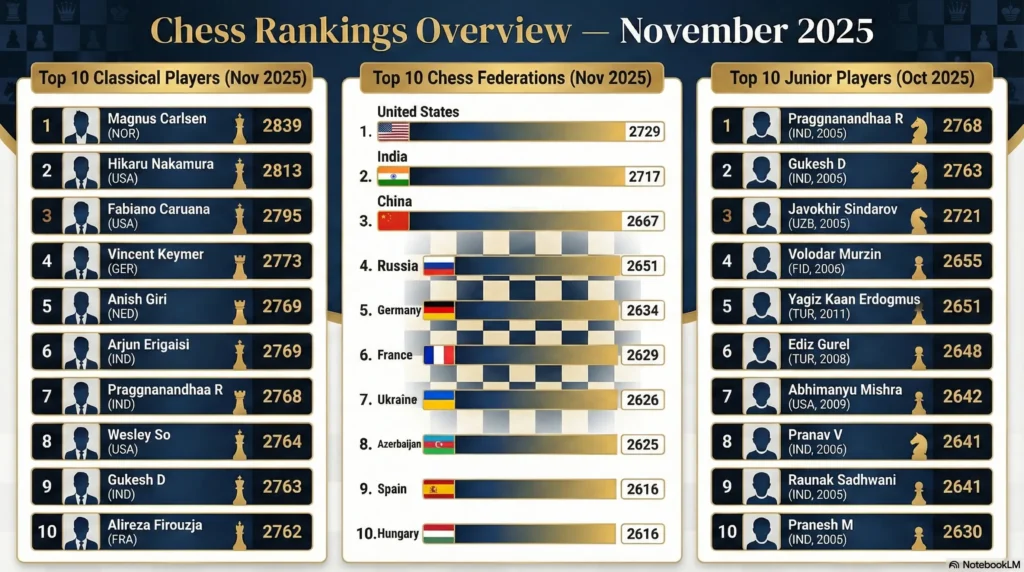The November 2025 rating lists offer one of the clearest snapshots yet of how global chess is evolving. From the established superstars at the top of the classical rankings, to the rapid rise of India and the United States, to the extraordinary new generation pushing the limits of what young players can achieve, this month’s tables highlight a sport in transformation. Below is a detailed look at the Top 10 classical players, the Top 10 federations, and the Top 10 juniors, and what these numbers say about the state of world chess today.
Carlsen Still Reigns, but the Chase Is Fierce
At the top of the Top 10 Classical Players list, Magnus Carlsen continues to prove why many consider him the greatest player in history. His 2839 Elo places him comfortably ahead of the field. Even years after stepping away from the world championship cycle, Carlsen’s dominance remains intact, and his rating leadership shows no signs of weakening.
Behind him is American superstar Hikaru Nakamura, sitting at 2813. Nakamura’s mix of classical consistency and exceptional rapid and blitz skills keeps him firmly among the elite. Fabiano Caruana, another leading American, holds third place at 2795, confirming his long-standing status as one of world chess’s most stable top performers.
One of the biggest stories in this month’s ranking is Vincent Keymer, the German prodigy who has climbed to world No. 4 with 2773. Keymer has long been viewed as the future of European chess, and his rise into the top five marks a historic milestone for Germany, which has not seen a player this high in decades.
The middle of the list features a tight cluster: Anish Giri (2769), Arjun Erigaisi (2769), Praggnanandhaa (2768), and Wesley So (2764). Their ratings differ by only a few points, underlining how competitive the modern elite has become. India’s presence in this group—with Erigaisi and Praggnanandhaa—reflects the country’s continuing surge.
Rounding out the Top 10 are Gukesh D (2763) and Alireza Firouzja (2762). Gukesh’s consistency at such a young age is remarkable, while Firouzja, long considered a future world champion, remains firmly among the world’s best.
Together, the Top 10 show a generational blend: icons like Carlsen and Nakamura, well-established powers like Caruana and So, and a growing youth wave from India, Germany, and France.
United States and India Lead the Federation Race
The Top 10 Federations by Average Rating tell a different but equally important story. For years, Russia dominated these lists, but 2025 marks a clear shift: the United States sits in first place with an average rating of 2729. With players like Nakamura, Caruana, So, and a deep pool of grandmasters, the U.S. has built an impressive ecosystem of talent, reinforced by top training, resources, and competition.
Right behind is India at 2717. India’s rise is one of the most significant developments in modern chess. With an explosion of young super-talents, strong national programs, and widespread popularity, India has now reached a level once thought possible only for long-established chess nations.
China (2667) and Russia (2651) take third and fourth. Although both countries remain traditional powerhouses, their averages reflect a period of transition. Younger players are emerging, but the depth of top-10 strength fluctuates compared to previous decades.
The rest of the top 10—Germany, France, Ukraine, Azerbaijan, Spain, and Hungary—represent nations with strong chess cultures and long histories of producing elite players. Germany’s presence in fifth place highlights Keymer’s influence, while France benefits from Firouzja and a solid supporting cast.
A Junior Generation Redefining Possibilities
Perhaps the most exciting section of the November lists is the Top 10 Juniors, which demonstrates just how extraordinary the next wave of chess talent has become.
The top two junior spots mirror parts of the classical top 10: Praggnanandhaa (2768) and Gukesh (2763) lead the world. Both are already among the strongest players of any age, and their long-term rivalry could define the next decade of elite chess.
In third is Javokhir Sindarov (2721), who continues Uzbekistan’s recent tradition of producing world-class talents. Young stars from Turkey—Yagiz Kaan Erdogmus (2011-born!) and Ediz Gurel—signal a broader geographic expansion of chess excellence.
The United States contributes Abhimanyu Mishra, once the world’s youngest grandmaster, who continues his steady rise. India, meanwhile, occupies an incredible four of the top ten spots, suggesting the country’s golden era has only just begun.

I’m a passionate board game enthusiast and a skilled player in chess, xiangqi and Go. Words for Attacking Chess since 2023. Ping me at Lichess for a game or chat.

